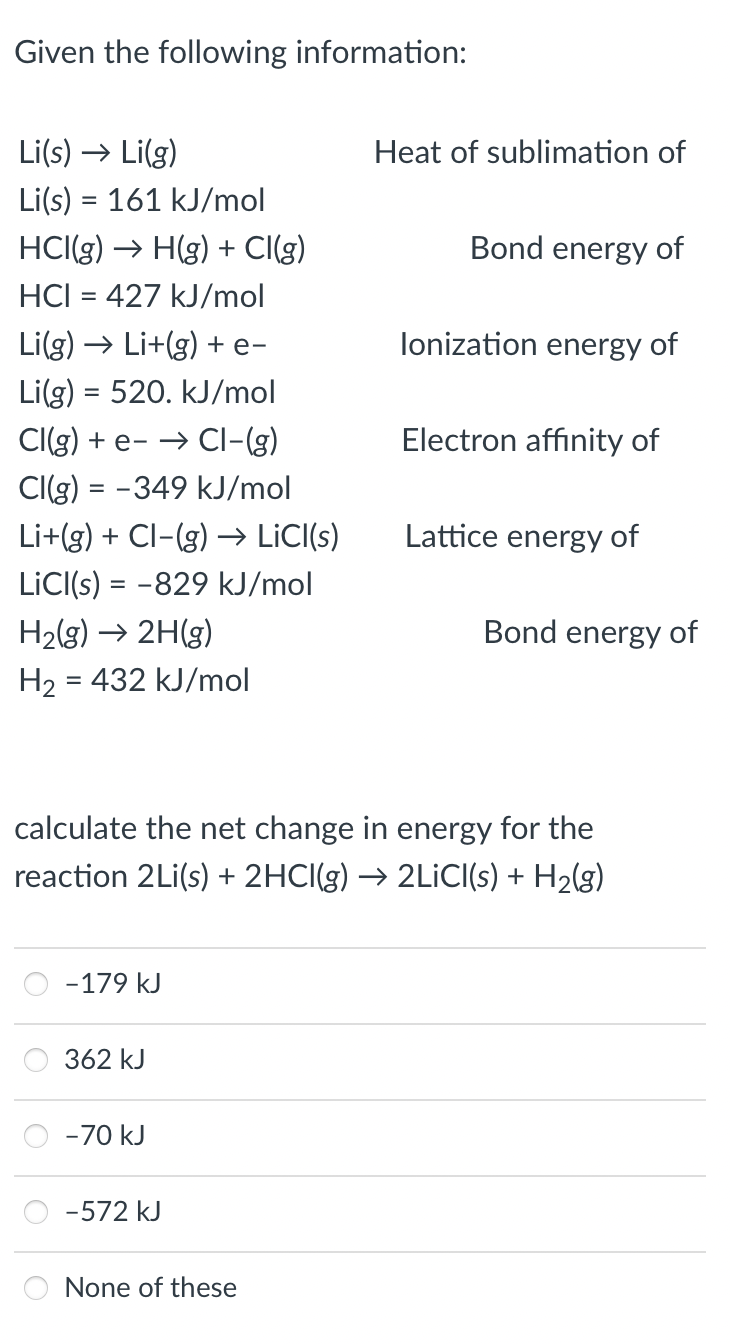Given the following information: Li(s) → Li(g) Li(s) = 161 kJ/mol Heat of sublimation of HCI(g) → H(g) + CI(g) Bond energy of HCI = 427 kJ/mol %3D Li(g) → Li+(g) + e- lonization energy of Li(g) = 520. kJ/mol Cl(g) + e- → Cl-(g) CI(g) = -349 kJ/mol Electron affinity of %3D Li+(g) + Cl-(g) –→ LİCI(s) Lattice energy of LİCI(s) = -829 kJ/mol %3D H2(g) → 2H(g) Bond energy of H2 = 432 kJ/mol calculate the net change in energy for the reaction 2Li(s) + 2HCI(g) → 2LİCI(s) + H2(g)
Given the following information: Li(s) → Li(g) Li(s) = 161 kJ/mol Heat of sublimation of HCI(g) → H(g) + CI(g) Bond energy of HCI = 427 kJ/mol %3D Li(g) → Li+(g) + e- lonization energy of Li(g) = 520. kJ/mol Cl(g) + e- → Cl-(g) CI(g) = -349 kJ/mol Electron affinity of %3D Li+(g) + Cl-(g) –→ LİCI(s) Lattice energy of LİCI(s) = -829 kJ/mol %3D H2(g) → 2H(g) Bond energy of H2 = 432 kJ/mol calculate the net change in energy for the reaction 2Li(s) + 2HCI(g) → 2LİCI(s) + H2(g)
Chemistry: The Molecular Science
5th Edition
ISBN:9781285199047
Author:John W. Moore, Conrad L. Stanitski
Publisher:John W. Moore, Conrad L. Stanitski
Chapter5: Electron Configurations And The Periodic Table
Section5.8: Ion Electron Configuration
Problem 5.16CE: Fluoride ion, F, has no unpaired electrons. Vanadium forms four binary fluoridesVF2, VF3, VF4, and...
Related questions
Concept explainers
Bond Parameters
Many factors decide the covalent bonding between atoms. Some of the bond parameters are bond angle, bond order, enthalpy, bond length, etc. These parameters decide what kind of bond will form in atoms. Hence it is crucial to understand these parameters in detail and understand how changing these parameters affects the kind of bonding or various characteristics.
Bond Dissociation Energy
The tendency of an atom to attract an electron is known as its electronegativity.
Question

Transcribed Image Text:Given the following information:
Li(s) → Li(g)
Li(s) = 161 kJ/mol
Heat of sublimation of
HCI(g) → H(g) + Cl(g)
Bond energy of
HCI = 427 kJ/mol
Li(g) → Li+(g) + e-
lonization energy of
Li(g) = 520. kJ/mol
CI(g) + e- → CI-(g)
Electron affinity of
Cl(g) = -349 kJ/mol
Li+(g) + Cl-(g) →→ LiC(s)
Lattice energy of
LİCI(s) = -829 kJ/mol
H2(g) → 2H(g)
Bond energy of
H2 = 432 kJ/mol
calculate the net change in energy for the
reaction 2Li(s) + 2HCI(g) → 2LİCI(s) + H2(g)
-179 kJ
362 kJ
-70 kJ
-572 kJ
None
ese
Expert Solution
This question has been solved!
Explore an expertly crafted, step-by-step solution for a thorough understanding of key concepts.
This is a popular solution!
Trending now
This is a popular solution!
Step by step
Solved in 2 steps

Knowledge Booster
Learn more about
Need a deep-dive on the concept behind this application? Look no further. Learn more about this topic, chemistry and related others by exploring similar questions and additional content below.Recommended textbooks for you

Chemistry: The Molecular Science
Chemistry
ISBN:
9781285199047
Author:
John W. Moore, Conrad L. Stanitski
Publisher:
Cengage Learning

Chemistry by OpenStax (2015-05-04)
Chemistry
ISBN:
9781938168390
Author:
Klaus Theopold, Richard H Langley, Paul Flowers, William R. Robinson, Mark Blaser
Publisher:
OpenStax

Principles of Modern Chemistry
Chemistry
ISBN:
9781305079113
Author:
David W. Oxtoby, H. Pat Gillis, Laurie J. Butler
Publisher:
Cengage Learning

Chemistry: The Molecular Science
Chemistry
ISBN:
9781285199047
Author:
John W. Moore, Conrad L. Stanitski
Publisher:
Cengage Learning

Chemistry by OpenStax (2015-05-04)
Chemistry
ISBN:
9781938168390
Author:
Klaus Theopold, Richard H Langley, Paul Flowers, William R. Robinson, Mark Blaser
Publisher:
OpenStax

Principles of Modern Chemistry
Chemistry
ISBN:
9781305079113
Author:
David W. Oxtoby, H. Pat Gillis, Laurie J. Butler
Publisher:
Cengage Learning

Chemistry: Principles and Practice
Chemistry
ISBN:
9780534420123
Author:
Daniel L. Reger, Scott R. Goode, David W. Ball, Edward Mercer
Publisher:
Cengage Learning

Chemistry for Engineering Students
Chemistry
ISBN:
9781337398909
Author:
Lawrence S. Brown, Tom Holme
Publisher:
Cengage Learning